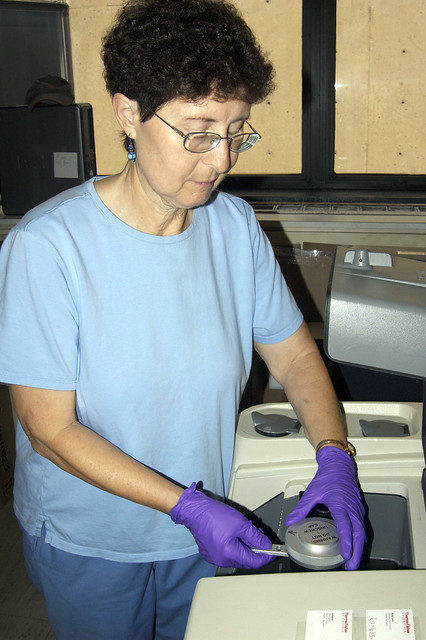A cesium magnetometer survey in 1978 located one of the largest early Iron Age burial caves ever found in Jordan. Some of the 227 excavated individuals in the tomb were adorned with pairs of iron anklets and bracelets. Our analyses showed that the metal was a mild steel, among the earliest instances of this iron-carbon alloy ever found.
The ancient pottery and glass vessel technology programs developed in the 1980’s were highly innovative at the time. We went on to tackle a long-ignored but all-important question: what did these vessels contain? A new field was pioneered that excited the scientific world and fired public imagination.
First came the chemical attestation of the earliest Royal Purple, the famous dye of the seafaring Phoenicians, demonstrating that organic compounds could survive over 3000 years.
In the early 1990’s, we announced the earliest chemically confirmed instances of grape wine and barley beer from the Near East. The laboratory then pushed back the earliest date for wine another two millennia to 5400 B.C., based on analyses of jars from the Museum’s excavation at Hajji Firuz in Iran.
In the late 1990’s, the laboratory analyzed the extraordinarily well-preserved organic residues inside the largest known Iron Age drinking-set, excavated inside the burial chamber of the Midas Tumulus at Gordion in Turkey. Our reconstruction of the “funerary feast”–which paired a mixed fermented beverage (“Midas Touch”) with a spicy, barbecued lamb and lentil stew–is the first time that an ancient meal has been re-created based solely on the chemical evidence.
Appropriately enough, “Midas Touch” has won three gold awards at major taste competitions in the past year.
Our research at the start of the new millennium has focused on the Neolithic period of ancient China’s Yellow River valley. At the site of Jiahu, we discovered the earliest alcoholic beverage in the world dating back to about 7000 B.C. It was a mixed fermented beverage of rice, honey, and grape and/or hawthorn fruit. A re-created beverage–“Chateau Jiahu”–was released in August 2006.
The research prowess of the Biomolecular Laboratory is matched by its publication record: 8 books and over 80 articles have been published in scientific journals, including a Nature cover story in its Dec. 23, 1999 issue.
Fifteen international stories have also publicized our remarkable discoveries to a wider public around the world in print media, on TV and radio, and over the internet. The laboratory’s research has been profiled in ten video programs, including a full-length feature filmed at the Midas Tumulus in Turkey. Our findings have been the focus of museum exhibits in Philadelphia, Athens, the Napa Valley, France, and elsewhere.
One can only imagine what will be excavated and analyzed in the coming years. We anticipate that many other organics–textiles, drugs, herbs and spices, even brains–will be recovered from well-preserved anoxic environments such as the deep oceans and seas, deserts, and glaciers.
Our laboratory will be called on to do the analyses, which will shed new light on the bio-cultures that have defined us as humans, including plant and animal domestication, human diet and trade, and ancient technology and innovation.
Beyond reconstructing ancient cuisine and human bio-culture by using advanced chemical techniques, a major goal of the Laboratory of Ancient Cuisine and Biomolecular Archaeology will be to “re-create” the past in its organic dimensions as never before.
New taste sensations, such as “Midas Touch” and “Chateau Jiahu,” will be one result of this experimental archaeological approach. By conjoining biomolecular archaeology with advanced artificial simulation techniques, much more of the human bio-cultural past can be “brought back to life.”
Gretchen R. Hall and Theodore Davidson, Ph.D. analytical chemists, are crucial to the research carried out by the laboratory.

